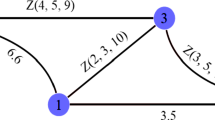Abstract
The focuses of this paper are optimal traffic regulation after a major disaster and evaluation of capacity reliability of a network. The paper firstly discusses the context of traffic regulation and its importance after a major disaster. Then, this problem is formulated as an optimisation program in which the traffic regulator attempts to regulate the amount of traffic movements or access to some areas so as to maximise the traffic volumes in the network while (a) link flows must be less than link capacities and (b) re-routing effect due to changes of traffic condition in the network is allowed. The re-routing behaviour is assumed to follow Probit Stochastic User's Equilibrium (SUE). The paper explains an optimisation algorithm based on an implicit programming approach for solving this problem with the SUE condition. With this optimisation problem, the randomness of the link capacities (to represent random effects of the disaster) is introduced and the paper describes an approach to approximate the capacity reliability of the network using Monte-Carlo simulation. The paper then adopts this approach to evaluate the performances of different traffic regulation policies with a small network and a test network of Kobe city in Japan.
Similar content being viewed by others
References
Athukorala PC, Resosudarmo BP (2005) The Indian Ocean tsunami: economics impact, disaster management and lessons, Working Paper in Trade and Development No 2005/05, Division of Economics, the Australian National University
Bazaraa MS, Sherali HD, Shetty CM (1993) Nonlinear programming: theory and algorithms. John Wiley & Sons, Inc., New York
Bell MGH (1999) Measuring network reliability: a game theoretic approach. J Adv Transp 33(2):135–146
Chen A, Yang H, Lo HK, Tang WH (2002) Capacity reliability of a road network: an assessment methodology and numerical results. Transp Res, Part B: Methodol 36(3):225–252
Chi-Chi Reconnaissance Team (2000) “Event report: Chi-CHi, Taiwan earthquake.” Risk Management Solutions, California, USA
Clark SD, Watling DP (2002) Sensitivity analysis of the probit-based stochastic user equilibrium assignment model. Transp Res, Part B: Methodol 36(7):617–635
Connors R, Sumalee A, Watling DP (2006a) Variable demand probit-based network design problem: implicit programming approach. Transp Res, Part B: Methodol. Submitted
Connors RD, Sumalee A, Watling DP (2006b) Sensitivity analysis of the variable demand probit stochastic user equilibrium with multiple user-classes. Transp Res, Part B: Methodol. Submitted
D’Este GM, Taylor MAP (2003) Network vulnerability: an approach to reliability analysis at the level of national strategic transport networks. In: Bell MGH, Iida Y (eds.) The network reliability of transport. Pergamon, Oxford
Du ZP, Nicholson AJ (1997) Degradable transportation systems: sensitivity and reliability analysis. Transp Res, B: Methodol 31(3):225–237
IATSS, Research Report (2000) Study on personal passenger car traffic regulation following the great earthquake disaster (in Japanese)
Kurauchi F, Iida Y (1998) Study on origin/destination flow fluctuations in the period following the Great Hansin-Awaji earthquake. IATSS Rev 23(3):146–154 (in Japanese)
Mendell NR, Elston RC (1974) Multifactorial qualitative traits: genetic analysis and prediction of recurrence risks. Biometrics 30:41–57
Rosa A (2003) Probit based methods in traffic assignment and discrete choice modelling, PhD thesis, Napier University
Sheffi Y (1985) Urban transportation networks: equilibrium analysis with mathematical programming methods. Prentice-Hall, Englewood Cliffs, New Jersey
Sumalee A, Connors R, Watling DP (2006) Optimal toll design problem with improved behavioural equilibrium model: the case of Probit model. In: Lawphongpanich S, Hearn DW, Smith MJ (eds.) Mathematical and computational models for congestion charging. Springer, Berlin Heidelberg New York
Author information
Authors and Affiliations
Corresponding author
Rights and permissions
About this article
Cite this article
Sumalee, A., Kurauchi, F. Network Capacity Reliability Analysis Considering Traffic Regulation after a Major Disaster. Netw Spat Econ 6, 205–219 (2006). https://doi.org/10.1007/s11067-006-9280-0
Published:
Issue Date:
DOI: https://doi.org/10.1007/s11067-006-9280-0



